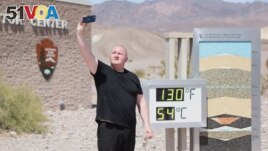17 July 2023
Even as temperatures continue to climb, visitors are still coming to see Death Valley National Park on the California-Nevada border.
The park is known as the hottest place on Earth. The National Park Service said on July 10, 1913, the hottest temperature recorded at Death Valley was 56.6 degrees Celsius.
Temperatures at or above 54.44 degrees Celsius have only been recorded on Earth a small number of times, mostly in Death Valley.

Scott Hughes, of Swansea, Wales, UK, takes a selfie next to a digital display of an unofficial heat reading at Furnace Creek Visitor Center during a heat wave in Death Valley National Park in Death Valley, California, on July 16, 2023. (Photo by Ronda Churchill / AFP)
This past weekend, the temperatures climbed to 53.33 degrees Celsius.
Most visitors at this time of year make it only a short distance to any area in the park before returning to the cool air in their vehicles.
But Daniel Jusehus from Germany chose to run in the heat earlier last week. He told the Associated Press, "I was really noticing, you know, I didn't feel so hot, but my body was working really hard to cool myself."
The active runner also took a photo of the thermometer outside Furnace Creek Visitor Center at the park. It showed the thermometer reading 48.8 degrees Celsius.
Early information from the park service shows that across the nation's 424 national parks, at least four people have died this year from heat-related causes. That includes a 65-year-old man from San Diego who was found dead in his vehicle at Death Valley earlier this month.
Death Valley National Park suggests visitors be careful and not have expectations of rescue. While park rangers drive on park roads and can assist motorists in need of help, there is no guarantee that lost visitors will get help in time.
More than 1.1 million people visit the desert park each year. At 13,848 square kilometers, Death Valley National Park is one of the largest national parks. About one-fifth of the visitors come in June, July and August.
Many visitors want to explore, even after the suggested cutoff times. Physical activity can make the heat feel even worse and leave people exhausted.
Park Ranger Nichole Andler said, "It does feel like the sun has gone through your skin and is getting into your bones."
Others mentioned feeling their eyes drying out from the hot wind sweeping through the valley.
Alessia Dempster, who was visiting from Edinburgh, Scotland, said, "It's very hot... especially when there's a breeze, you would think that maybe that would give you some slight relief from the heat, but it just really does feel like an air blow dryer just going back in your face."
Death Valley is a narrow area that is below sea level and surrounded by high, steep mountains, the park service's website says. The dry air and small plant coverage let sunlight heat up the desert surface. The heat then becomes trapped in the valley.
The park's brownish hills have signs saying, "heat kills" and other warnings.
Still, several areas in Death Valley continue to draw tourists. Badwater Basin, made up of salt flats, is considered the lowest point in all of North America. The 183-meter Ubehebe Crater dates back over 2,000 years. And Zabriskie Point is a great sunrise viewing spot.
Eugen Chen from Taiwan called the park "beautiful" and a "very special place."
Josh Miller, a visitor from Indianapolis who has been to 20 national parks so far, shared that feeling.
"It's hot, but the scenery is awesome," he said.
I'm John Russell.
Ty O'Neil reported on this story for the Associated Press. John Russell adapted it for VOA Learning English.
_____________________________________________________
Words in This Story
notice – v. to become aware of (something or someone) by seeing, hearing, etc.
ranger – n. a person in charge of managing and protecting part of a public forest
breeze – n. a gentle wind
relief – n. the removal or reduction of something that is painful or unpleasant
steep – adj. going up or down very quickly
scenery – n. a view of natural features (such as mountains, hills, valleys)